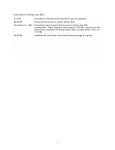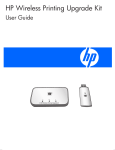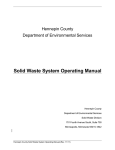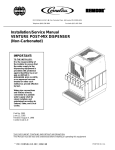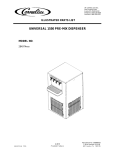Download Installation/Service Manual Remote Condensing Unit
Transcript
CORNELIUS INC g One Cornelius Place g Anoka, MN 55303-6234 Telephone (800) 238-3600 Facsimile (612) 422-3246 Installation/Service Manual REMOTE CONDENSING UNIT UNIT PART NUMBERS: 416117-0001 (R-404A Refrigerant) 496117-0001 (R-404A Refrigerant) Publication Number: 301138000 Revision Date: May 06, 2014 Revision: B THIS DOCUMENT CONTAINS IMPORTANT INFORMATION This Manual must be read and understood before installing or operating this equipment © 1997-2014 CORNELIUS INC. PRINTED IN U.S.A TABLE OF CONTENTS Page SAFETY INFORMATION . . . . . . . . . . . . . . . . . . . . . . . . . . . . . . . . . . . . . . . . . . . . . . . . . . . . 1 RECOGNIZE SAFETY INFORMATION . . . . . . . . . . . . . . . . . . . . . . . . . . . . . . . 1 UNDERSTAND SIGNAL WORDS . . . . . . . . . . . . . . . . . . . . . . . . . . . . . . . . . . . . 1 FOLLOW SAFETY INSTRUCTIONS . . . . . . . . . . . . . . . . . . . . . . . . . . . . . . . . . 1 CO2 (CARBON DIOXIDE) WARNING . . . . . . . . . . . . . . . . . . . . . . . . . . . . . . . . 1 INSTALLATION . . . . . . . . . . . . . . . . . . . . . . . . . . . . . . . . . . . . . . . . . . . . . . . . . . . . . . . . . . . . 3 TO THE USER OF THIS MANUAL . . . . . . . . . . . . . . . . . . . . . . . . . . . . . . . . . . . . . . . 3 DESCRIPTION . . . . . . . . . . . . . . . . . . . . . . . . . . . . . . . . . . . . . . . . . . . . . . . . . . . . . . . . 3 UNPACKING AND INSPECTION . . . . . . . . . . . . . . . . . . . . . . . . . . . . . . . . . . . . . . . . 4 INSTALLATION . . . . . . . . . . . . . . . . . . . . . . . . . . . . . . . . . . . . . . . . . . . . . . . . . . . . . . . . 4 SELECTING LOCATION . . . . . . . . . . . . . . . . . . . . . . . . . . . . . . . . . . . . . . . . . . . 4 INSTALLING REMOTE CONDENSING UNIT . . . . . . . . . . . . . . . . . . . . . . . . 5 SERVICE AND MAINTENANCE . . . . . . . . . . . . . . . . . . . . . . . . . . . . . . . . . . . . . . . . . . . . . 7 PERIODIC INSPECTION . . . . . . . . . . . . . . . . . . . . . . . . . . . . . . . . . . . . . . . . . . . . . . . 7 LUBRICATION . . . . . . . . . . . . . . . . . . . . . . . . . . . . . . . . . . . . . . . . . . . . . . . . . . . . . . . . 7 CLEANING CONDENSER COIL . . . . . . . . . . . . . . . . . . . . . . . . . . . . . . . . . . . . . . . . . 7 TROUBLESHOOTING . . . . . . . . . . . . . . . . . . . . . . . . . . . . . . . . . . . . . . . . . . . . . . . . . . . . . . 11 TROUBLESHOOTING REFRIGERATION COMPRESSOR . . . . . . . . . . . . . . . . . . 11 COMPRESSOR COOLS BUT IS VERY NOISY ESPECIALLY WHEN STOPPING AND STARTING . . . . . . . . . . . . . . . . . . . . . . . . . . . . . . . . . . . . . . . . 11 COMPRESSOR COOLS, BUT IS MODERATELY NOISY; LOUD ENOUGH TO BE NOTICED, BUT NO SHARP BANGS OR CLATTERING . . . . . . . . . 11 COMPRESSOR OPERATES BUT REFRIGERATION SYSTEM DOES NOT COOL . . . . . . . . . . . . . . . . . . . . . . . . . . . . . . . . . . . . . . . . . . . . . . . . . . . . . . . 11 COMPRESSOR STARTS AND OPERATES FOR A FEW SECONDS, THEN STOPS . . . . . . . . . . . . . . . . . . . . . . . . . . . . . . . . . . . . . . . . . . . . . . . . . . . . . 11 COMPRESSOR WILL NOT START . . . . . . . . . . . . . . . . . . . . . . . . . . . . . . . . . . 11 COMPRESSOR STARTS BUT WILL NOT OPERATE FOR MORE THAN A FEW SECONDS . . . . . . . . . . . . . . . . . . . . . . . . . . . . . . . . . . . . . . . . . . . . . . . . . 12 TROUBLESHOOTING REMOTE CONDENSING UNIT . . . . . . . . . . . . . . . . . . . . . 14 COMPRESSOR DOES NOT OPERATE. . . . . . . . . . . . . . . . . . . . . . . . . . . . . . 14 COMPRESSOR OPERATES CONTINUOUSLY BUT DOES NOT COOL SUFFICIENTLY . . . . . . . . . . . . . . . . . . . . . . . . . . . . . . . . . . . . . . . . . . . . . . . . . . . 14 CONDENSER FAN MOTOR NOT OPERATING. . . . . . . . . . . . . . . . . . . . . . . . 14 PARTS LIST . . . . . . . . . . . . . . . . . . . . . . . . . . . . . . . . . . . . . . . . . . . . . . . . . . . . . . . . . . . . . . 15 TABLE OF CONTENTS (cont’d) Page LIST OF FIGURES FIGURE 1. REMOTE CONDENSING UNIT . . . . . . . . . . . . . . . . . . . . . . . . . . . . . . . 3 FIGURE 2. PARTS IDENTIFICATION . . . . . . . . . . . . . . . . . . . . . . . . . . . . . . . . . . . . 8 FIGURE 3. REFRIGERATION FLOW DIAGRAM . . . . . . . . . . . . . . . . . . . . . . . . . . . 9 FIGURE 4. WIRING DIAGRAM . . . . . . . . . . . . . . . . . . . . . . . . . . . . . . . . . . . . . . . . . . 10 FIGURE 5. REMOTE CONDENSER ASS’Y . . . . . . . . . . . . . . . . . . . . . . . . . . . . . . . 15 LIST OF TABLES TABLE 1. DESIGN DATA . . . . . . . . . . . . . . . . . . . . . . . . . . . . . . . . . . . . . . . . . . . . . . . 3 SAFETY INFORMATION Recognize Safety Information This is the safety-alert symbol. When you see this symbol on our machine or in this manual, be alert to the potentially of personal injury. Follow recommended precautions and safe operating practices. Understand Signal Words A signal word - DANGER, WARNING, OR CAUTION is used with the safety-alert symbol. DANGER identifies the most serious hazards. Safety signs with signal word DANGER or WARNING are typically near specific hazards. General precautions are listed on CAUTION safety signs. CAUTION also calls attention to safety messages in this manual. DANGER WARNING CAUTION Follow Safety Instructions Carefully read all safety messages in this manual and on your machine safety signs. Keep safety signs in good condition. Replace missing or damaged safety signs. Learn how to operate the machine and how to use the controls properly. Do not let anyone operate the machine without instructions. Keep your machine in proper working condition. Unauthorized modifications to the machine may impair function and/or safety and affect the machine life. CO2 (Carbon Dioxide) Warning CO2 Displaces Oxygen. Strict Attention must be observed in the prevention of CO2 (carbon dioxide) gas leaks in the entire CO2 system. If a CO2 gas leak is suspected, particularly in a small area, immediately ventilate the contaminated area before attempting to repair the leak. Personnel exposed to high concentration of CO2 gas will experience tremors which are followed rapidly by loss of consciousness and suffocation. Publication Number: 301138000 1 © 1997-2014 Cornelius Inc. THIS PAGE LEFT BLANK INTENTIONALLY © 1997-2014 Cornelius Inc. 2 Publication Number: 301138000 INSTALLATION TO THE USER OF THIS MANUAL This manual is a guide for installing and maintaining this equipment. Refer to Table of Contents for page location of detailed information pertaining to questions that may arise during installation, service and maintenance, or troubleshooting this equipment. This Unit must be installed and serviced by a qualified Service Person. This Unit contains no user serviceable parts. DESCRIPTION The Remote Condensing Unit consists basically of a refrigeration compressor, a receiver tank, a fan cooled condenser coil, a head pressure control, and a strainer/dryer mounted on an enclosed platform. The Remote Condensing Coil Unit (see Figure 1) is designed to be used with any Evaporator Assembly with a rated temperature range of -10_F to -32_F. The Evaporator Assembly is connected by refrigeration lines and is refrigerated by the Remote Condensing Unit. FIGURE 1. REMOTE CONDENSING UNIT Table 1. Design Data REMOTE CONDENSING UNIT Unit Part No. 230V, 60 HZ Unit (R-404A Refrigerant) 4161170001 230V, 50 HZ Unit (R-404A Refrigerant) 4961170001 Overall Dimensions: Height 22-1/4 inches Width 28-1/2 inches Depth 25-3/4 inches Shipping Weight (approx) Publication Number: 301138000 290 Pounds 3 © 1997-2014 Cornelius Inc. Table 1. Design Data (cont’d) Ambient Operating Temperature –20_F to 120_F Refrigeration Requirements: Refrigeration Type and Charge See Unit Nameplate Electrical Requirements: Operating Voltage See Unit Nameplate Current Draw See Unit Nameplate UNPACKING AND INSPECTION NOTE: The Remote Condensing Unit was thoroughly inspected before leaving the factory and the carri-er has accepted and signed for it. Any damage or irregularities should be noted at time of delivery (ornot later than 15 days from date of delivery) and immediately reported to the delivering carrier. Requesta written inspection report from Claims Inspector to substantiate any necessary claim. File claim withthe delivering carrier, not with Cornelius Inc. 1. Unpack Remote Condensing Unit. Remove all shipping tape and packing materials. 2. Inspect and make sure Remote Condensing Unit is in good condition as instructed in preceding NOTE. INSTALLATION SELECTING LOCATION Locate the Remote Condensing Unit so the following requirements are satisfied: 1. The Remote Condensing Unit must be installed in a location which will allow shortest possible refrigeration lines route (not to exceed 50–feet in length) from Condensing Unit to the Evaporator Assembly. The Condensing Unit must not be installed more than 10–feet below the Evaporator Assembly Dispenser. DANGER: To avoid possible fatal electrical shock or serious injury to the operator, it is highly recommended that a GFI (ground fault circuit interrupt) be installed in the electrical circuit for the 60 Hz Units. It is required that an ELCB (earth leakage circuit breaker) be installed in the electrical circuit for the 50 Hz Units. 2. Close to a properly grounded 208/230 VAC 60HZ or 220/240 VAC 50HZ single-phase electrical circuit with a 30-amp minimum-rated disconnect switch (not provided) fused at 25-amps (‘‘slow-blow’’) or power circuit connected through an equivalent HACR circuit breaker must be available to the Unit. Use No. 8 AWG copper wire, or larger, depending upon line length, in suitable conduit or BX sheath. POWER CIRCUIT MUST BE MADE UP OF COPPER CONDUCTORS AND ALL WIRING MUST CONFORM TO NATIONAL AND LOCAL CODES. MAKE SURE UNIT IS PROPERLY GROUNDED. 3. An extreme warm climate installation may require extra caution in Remote Condensing Unit location. Avoid hot sunny locations and seek shaded area if possible. If Remote Condensing Unit is to be installed on the rooftop, the use of a structure to shade the Unit from direct sun exposure and/or a platform extending Unit an additional 18–inches above the roof is highly recommended and will improve performance. Ample space (24 inches on all sides and 48 inches above Unit) must be provided for proper air circulation through the Unit and also access for service and maintenance. DO NOT BLOCK AIR CIRCULATION THROUGH THE UNIT. © 1997-2014 Cornelius Inc. 4 Publication Number: 301138000 4. If the Remote Condensing Unit is installed on the rooftop, the Unit must be installed in a level position and must be anchored with adequate fastening devices. INSTALLING REMOTE CONDENSING UNIT (see Figures 2, 3, and 4) 1. Install Remote Condensing Unit meeting requirements of SELECTING LOCATION. The Unit must be installed in a level position and must be anchored with adequate fastening devices. NOTE: The following Refrigeration Lines Kits are recommended to connect the Remote CondensingUnit to the Evaporator Assembly. Contact Cornelius if refrigeration lines exceed 50 feet in length. Part No. Description 308900025 Refrigeration Lines Kit, 25-ft. long 90_ (insulated 3/8 O.D. Liquid and 5/8 O.D. Discharge) 308900050 Refrigeration Lines Kit, 50-ft. long 90_ (insulated 3/8 O.D. Liquid and 5/8 O.D. Discharge) 2. Route refrigeration lines from Remote Condensing Unit to the Evaporator Assembly. 3. Connect ends of refrigeration lines to Remote Condensing Unit refrigeration connectors. 4. Remove four screws securing Remote Condensing Unit top cover, then remove cover for access to electrical control box. 5. Remove one screw securing electrical control box cover, then remove cover. WARNING: The Remote Condensing Unit must be electrically grounded to avoided possible fatal electrical shock or serious injury to the operator. A green ground wire is provided inside electrical control box to connect power circuit ground wire which electrically grounds the Unit. 6. Connect 208/230 VAC 60HZ or 220/240 VAC 50 HZ Single-Phase electrical power circuit (meeting requirements of SELECTING LOCATION) to L1 and L2 (N) terminals on contactor inside the Unit electrical control box as shown in FIGURE NO TAG. MAKE SURE POWER CIRCUIT GREEN GROUND WIRE IS INSTALLED UNDER GREEN GROUND SCREW INSIDE ELECTRICAL CONTROL BOX TO PROPERLY GROUND THE UNIT. POWER CIRCUIT MUST BE MADE UP OF COPPER CONDUCTORS AND ALL WIRING MUST CONFORM TO NATIONAL AND LOCAL ELECTRICAL CODES. 7. A 24 VAC power circuit, which must conform to national and local electrical codes, must be routed and connected between the Evaporator Assembly Temperature Control and the Remote Condensing Unit. Purpose of the 24VAC power control circuit is to allow the Evaporator Assembly Temperature Control to control ‘‘ON’’ and ‘‘OFF’’ operation of the Remote Condensing Unit. Route and connect 24VAC power control circuit between the Evaporator Assembly and the Remote Condensing Unit as follows: A. Route 24 VAC power control circuit electrical wires through hole in end panel to inside of the Remote Condensing Unit. B. Connect 24 VAC power control circuit electrical wires to labeled 24 V grey and red wires hanging out of the electrical control box. C. Install electrical control box cover and secure with screw. D. Route 24VAC power control circuit from Remote Condensing Unit to the Evaporator Assembly location. E. Refer to manual provided with the Evaporator Assembly for instructions to connect 24VAC power circuit to Evaporator Assembly Temperature Control. Publication Number: 301138000 5 © 1997-2014 Cornelius Inc. THIS PAGE LEFT BLANK INTENTIONALLY © 1997-2014 Cornelius Inc. 6 Publication Number: 301138000 SERVICE AND MAINTENANCE This section describes service and maintenance procedures to be performed on the Unit. WARNING: Disconnect electrical power to Remote Condensing Unit to prevent personal injury before attempting any internal maintenance. Only qualified personnel should service internal components or electrical wiring. PERIODIC INSPECTION Make sure Remote Condensing Unit Condenser Coil is free from debris. Restricting air through the condenser coil will decrease the refrigeration systems cooling efficiency. LUBRICATION The Remote Condensing Unit condenser fan motor must be lubricated once every six months with S.A.E. 20W oil. DO NOT OVER OIL. CLEANING CONDENSER COIL CAUTION: Remote Condensing Unit is equipped with a condenser coil that must be cleaned every 30 days. Allowing condenser coil to become clogged will cause refrigeration system to overheat which will automatically shut refrigeration system down. After condenser coil has been cleaned, high–pressure cutout sensing switch (located inside the Remote Condensing Unit electrical control box) will automatically reset to restart the refrigeration system. OPERATING IN THIS MANNER FOR PROLONGED PERIODS OF TIME COULD RESULT IN COMPRESSOR FAILURE. The Remote Condensing Unit condenser coil must be cleaned every 30 days. Circulating air, required to cool the coil, is drawn in through the coil and is exhausted out through grilles on end and back of the Unit. Clean condenser coil as follows: 1. Disconnect electrical power from Evaporator Assembly 24VAC Temperature Control. 2. Disconnect electrical power to Remote Condensing Unit at disconnect switch. 3. Remove four screws securing top cover on Remote Condensing Unit, then remove cover. 4. Clean condenser coil using vacuum cleaner, whisk broom, or a soft–bristle brush to remove any debris from coil. 5. Make sure fan blade is not out of balance, is not bent, and is not striking any surface during rotation. 6. If the Remote Condensing Unit has been installed on the rooftop check and make sure roof area immediately surrounding the Remote Condensing Unit is free and clear of any debris that may have collected such as leaves, paper, trash, etc. 7. Install top cover on Remote Condensing Unit and secure with four screws. 8. Restore electrical power to Remote Condensing Unit at disconnect switch. 9. Restore electrical power to Evaporator Assembly 24VAC Temperature Control. Publication Number: 301138000 7 © 1997-2014 Cornelius Inc. TOP COVER TOP COVER RETAINING SCREW(4) COMPRESSOR CONDENSER COIL ELECTRICAL CONTROL BOX CONDENSER FAN MOTOR RECEIVER TANK REFRIGERATION LINES CONNECTORS FIGURE 2. PARTS IDENTIFICATION © 1997-2014 Cornelius Inc. 8 Publication Number: 301138000 REMOTE ROOFTOP CONDENSING UNIT STRAINER/DRYER PROCESS LINE HIGH-PRESSURE CUTOUT SWITCH SERVICE VALVE (2) CONDENSER COIL COMPRESSOR RECEIVER TANK CONDENSER FAN/HEATER SWITCH CONDENSER MOTOR/FAN HEAD PRESSURE CONTROL EVAPORATOR ASSEMBLY (MUST NOT BE INSTALLED MORE THAN 10–FEET ABOVE REMOTE CONDENSING UNIT) REFRIGERATION LINES (NOT TO EXCEED 50–FEET IN LENGTH) FIGURE 3. REFRIGERATION FLOW DIAGRAM Publication Number: 301138000 9 © 1997-2014 Cornelius Inc. FIGURE 4. WIRING DIAGRAM © 1997-2014 Cornelius Inc. 10 Publication Number: 301138000 TROUBLESHOOTING IMPORTANT: Only qualified personnel should service internal components or electrical wiring. WARNING: If repairs will be made to Remote Condensing Unit, turn off electrical power to Evaporator Assembly, then disconnect power to Remote Condensing Unit at disconnect switch before proceeding. Trouble Probable Cause Remedy TROUBLESHOOTING REFRIGERATION COMPRESSOR COMPRESSOR COOLS BUT IS VERY NOISY ESPECIALLY WHEN STOPPING AND STARTING A. Compressor cools, but is very noisy, especially when stopping and starting. This is either a broken suspension spring or loose crank shaft extension. A. Compressor must be changed. COMPRESSOR COOLS, BUT IS MODERATELY NOISY; LOUD ENOUGH TO BE NOTICED, BUT NO SHARP BANGS OR CLATTERING A. Compressor cools but is moderately noisy, loud enough to be somewhat annoying, but no sharp bangs or clattering. A. This is probably a discharge or suction tube rattling inside the compressor. If noise level can be tolerated, compressor need not be changed. The noise will not affect the performance or shorten compressor life. COMPRESSOR OPERATES BUT REFRIGERATION SYSTEM DOES NOT COOL A. Look for a refrigerant leak or oil at tubing joints. If compressor is moderately noisy and no leaks are evident, it is probably a broken valve inside compressor A. Compressor must be changed. COMPRESSOR STARTS AND OPERATES FOR A FEW SECONDS, THEN STOPS A. Compressor running too hot due to condenser coils plugged with dust, lint, and grease restricting cooling air flow through the condenser coil. A. Clean condenser coil with vacuum cleaner, low-pressure compressed air, or soft brush, then allow compressor to cool and restart. COMPRESSOR WILL NOT START A. Check line voltage across ‘‘T‘’ terminals on contactor. A. Voltage cannot be less than 198 V to start compressor. B. loose or disconnected wires. B. Correct the loose or disconnected wires. C. Check control circuit; C. Contactor must pull in. D. Examine start capacitor for signs of excessive heat (blown up). Check for open by connecting test cord and checking amp draw. D. If no current is drawn (or very little), capacitor is open and must be replaced. If capacitor is blown, look for inoperable start relay or low voltage.. Note: If all above checks have been made and compressor will not start, increase start capacitor value by about 15% and try to start. This can be done two ways: (The substitute capacitor must have voltage rating equal to or greater than the existing start capacitor) a. Remove existing capacitor and replace with one having a 15% greater MFD rating or (step b). b. Wire capacitor that has 15% of the MFD rating in parallel with the existing capacitor. c. Try to start compressor. If all the previous (steps a and b) will not make compressor operate, label compressor ‘‘stuck’’ and replace. Publication Number: 301138000 11 © 1997-2014 Cornelius Inc. Trouble COMPRESSOR STARTS BUT WILL NOT OPERATE FOR MORE THAN A FEW SECONDS Probable Cause A. Inoperable Start Relay. Remedy A. Replace start relay. B. If less than 198 V is present, upgrade Unit power source. Note: To check relay, remove wire from No. 1 terminal on start relay and touch to No. 2 terminal. Start compressor and immediately remove wire from No. 2 terminal. If compressor starts and operates, problem is in the start relay. B. Low Voltage. Note: Remove compressor terminals cover and connect voltmeter test leads between ‘‘C’’ (top terminal) and ‘‘R’’ (lower right terminal). Start compressor. A minimum of 198 VAC (nominal) must be present to operate compressor WARNING: To avoid electrical shock even after electrical power has been disconnected from Unit, run capacitor must be discharged by momentarily touching both capacitor terminals at the same time using an insulated handled screwdriver. C. © 1997-2014 Cornelius Inc. Inoperative Run Capacitor. 12 C. Inspect capacitor for bulges, cracks, or any external deformation. If found, assume capacitor is inoperable and replace. If none of the above conditions are evident, disconnect wires from capacitor. Connect test cord to capacitor terminals. Connect ammeter to one wire of test cord, Plug test cord into electrical outlet and record amp reading. *See formula on next page at end of this trouble topic. Publication Number: 301138000 Trouble COMPRESSOR STARTS BUT WILL NOT OPERATE FOR MORE THAN A FEW SECONDS (CONT’D) Probable Cause D. Grounded or Shorted Motor Windings. Remedy D. Disconnect all electrical wires from compressor terminals. Set ohmmeter on 100,000 ohm scale. touch one lead to copper line or bare metal of compressor. Touch other lead to each of the compressor terminals in succession. Continuity must not be indicated. If an ohmmeter reading is obtained, then compressor is grounded and must be replaced. To check for shorted windings, set ohmmeter on 10 ohm scale. Attach one lead to ‘‘C’’ (top terminal). The reading should be approximately 1 to 1-1/2 ohms. Leave one lead on ‘‘C‘’ terminal and touch other lead to ‘‘S‘’ (lower left terminal).The reading should be 3-1/2 to 5 Ohms. Leave one lead on ‘‘S’’ terminal and touch other lead to ‘‘R’’ terminal. This reading should be exactly the sum of the first two readings obtained. If the resistance readings do not fall within these limits, the compressor is ‘‘shorted’’ or has an ‘‘open’’ winding and must be replaced. Replace compressor. 2650xAmp *Use amps reading in formula voltsń60HZ = M.F.D. to determine actual value of capacitor. If calculated actual value is 10% more or less than rated value, replace capacitor. Publication Number: 301138000 13 © 1997-2014 Cornelius Inc. Trouble Probable Cause Remedy TROUBLESHOOTING REMOTE CONDENSING UNIT COMPRESSOR DOES NOT OPERATE. COMPRESSOR OPERATES CONTINUOUSLY BUT DOES NOT COOL SUFFICIENTLY CONDENSER FAN MOTOR NOT OPERATING. © 1997-2014 Cornelius Inc. A. Evaporator Assembly not calling for refrigeration. A. Refrigeration not called for. B. Electrical power to Remote Condensing Unit turned off. B. Turn on electrical power to Remote Condensing Unit. C. Electrical power to Evaporator Assembly turned off. C. Turn on electrical power to Evaporator Assembly. D. No Remote Condensing Unit power source. Blown fuse or tripped circuit breaker. D. Replace fuse or reset circuit breaker. E. Loose, disconnected, or broken wiring. E. Tighten connections or replace broken wiring F. High–pressure cutout switch tripped. F. High-pressure cutout switch will automatically reset after refrigeration system pressure has lowered (see CAUTION note under CLEANING CONDENSER COIL). G. Low voltage. G. Voltage must be at least 198 V at compressor terminals when compressor is trying to start. H. Inoperable run capacitor, or start relay. H. Replace inoperable part. I. Inoperable compressor. I. Replace compressor. A. Refrigeration capacity is exceeded by product overdrawing. A. Reduce amount of product drawn per given time. B. Air circulation through Remote Condensing Unit condenser coil is restricted. B. Check and if necessary, clean condenser coil as instructed. C. Insufficient refrigerant charge. C. Find and repair refrigeration leak, then replenish refrigerant charge. A. Fan blade obstructed A. Remove obstruction. B. Inoperative condenser fan motor. B. Replace condenser fan motor. C. Compressor contactor inoperable. C. Replace compressor contactor. D. Disconnected or broken electrical wire. D. Connect or repair broken electrical wire. 14 Publication Number: 301138000 PARTS LIST UNIT PART NUMBERS: 416117-0001 496117-0001 40. 24. 33. 1. 36. 35. 34. 31. 2. 32. 42. 1. 25. 1. 30. 6. 28. 16. 27. 1. 26. 41. 29. 11. 12. 13. 14. 15. 18. 19. 1. 1. 21. 23. 9. 17. 41. 43. 1. 1. 20. 1. 8. 7. 44. 10. 5. 1. 9. 37. 22. 3. 4. 1. 1. FIGURE 5. REMOTE CONDENSER ASS’Y Publication Number: 301138000 15 © 1997-2014 Cornelius Inc. 1. REMOTE CONDENSER ASS’Y (CON’T) Item Part No. Description 4161170001 Remote Condenser Ass’y, 230V 60HZ 4961170001 Remote Condenser Ass’y, 230V 50HZ 1. *319941000 Thread Rolling Screw, SL Hex Washer HD. No. 8-32 By 3/8 in. Long 2. 324153068 Cover, Remote Condenser 3. 324151068 Panel, Right-Side 4. 324152068 Panel, Back 5. 324150068 Panel, Left-Side 6. 324148000 Condenser Coil 7. 309215000 Pressure Control 8. 3557 Dryer 9. *189429000 Hex Nut, 1/4-20 10. 5041 Receiver 11. *186146000 Hex Nut, 5/16-18 12. *186148000 Washer, Lock, .319 I.D. 13. 318418000 Washer .312 I.D. 14. 3609 Spacer 15. 3608 Grommet 16. 3726 Compressor, 230V 60HZ 3725 Compressor, 230V 50HZ 17. 309919000 Flange, 3/8 18. 309920000 Flange, 1/2 19. 309895011 Bracket, Coupler 20. 324155000 Bracket, Motor 21. 2893 Motor, 1/6 H.P., 230V. 60HZ 2115 Motor, 1/6 H.P., 230V. 50HZ 22. 324145000 Blade, Fan 23. 324154000 Shroud 24. 4999 Control Box 25. 324156000 Cover, Control Box 26. 324172000 Strap, Capacitor Fan 27. 324143000 Capacitor, Start, Fan 28. 325956000 Strap, Capacitor © 1997-2014 Cornelius Inc. 16 Publication Number: 301138000 REMOTE CONDENSER ASS’Y (CON’T) 29. 325518000 Capacitor, Run, 230V 60HZ 3617 Capacitor, Run, 230V 50HZ 30. 40284000 Capacitor, Start 31. 40285 Relay, Start 32. 324209000 Pressure Switch, HI, 200 PSI 33. 329473000 Contactor, 24V. 34. *325069000 Machine Screw, S: Hex HD, No. 10-24 by 1/2-in. Long 35. 325145000 Washer, #10 36. 325644000 Lug 37. 5042 Base 38. *187552000 Machine Screw, Phil RD HD, No. 8-32 by 1/4-in. Long (Not Shown) 39. 309524011 Cord (Not Shown) 40. 320734000 Self-Threaded Screw, Phil Pan HD. No. 6-32 by 3/8-in. Long 41. 313802000 Snap Bushing 42. 324208000 Pressure Switch, HI, 405 PSIG 43. 960194000 Edging, Grommet 44. 324215000 Heater, 138 Watt, 220V. 60Hz Publication Number: 301138000 17 © 1997-2014 Cornelius Inc. THIS PAGE LEFT BLANK INTENTIONALLY © 1997-2014 Cornelius Inc. 18 Publication Number: 301138000 CORNELIUS INC. CORPORATE HEADQUARTERS: One Cornelius Place Anoka, Minnesota 55303-6234 (612) 421-6120 (800) 238-3600






















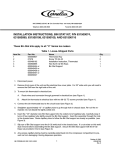
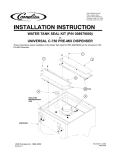
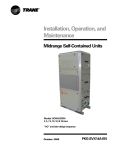
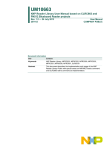
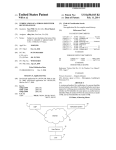
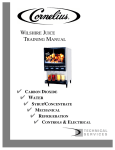
![Service Manual VA13 Carbonator [ 002818 ]](http://vs1.manualzilla.com/store/data/006013608_1-0f8f87056a0ab013b1dd01dac3912d47-150x150.png)
